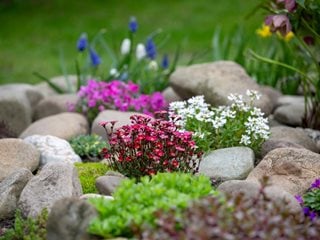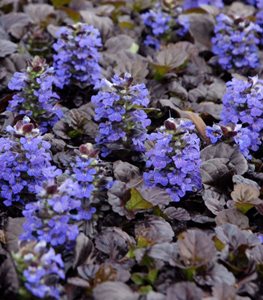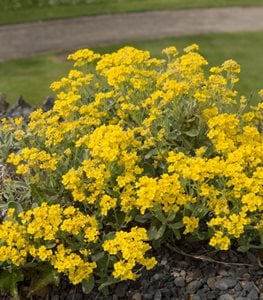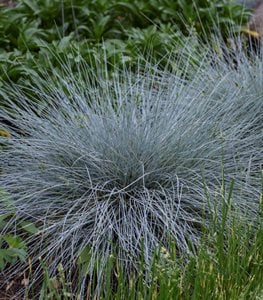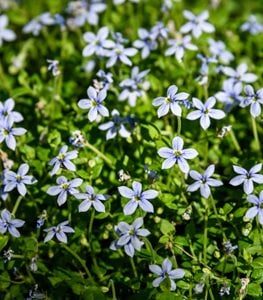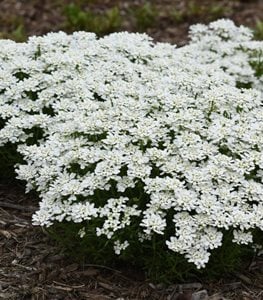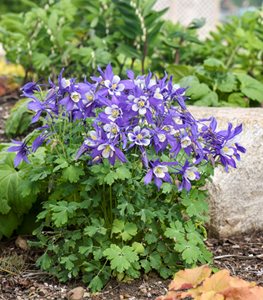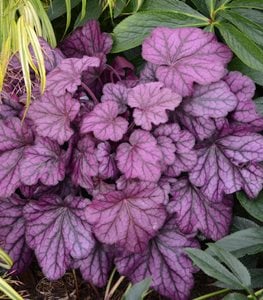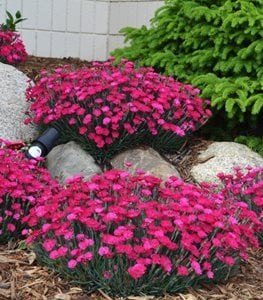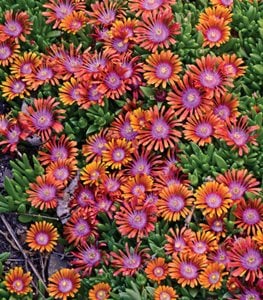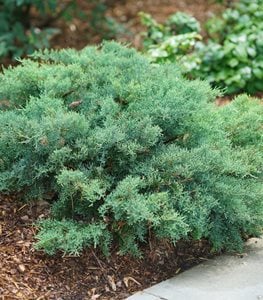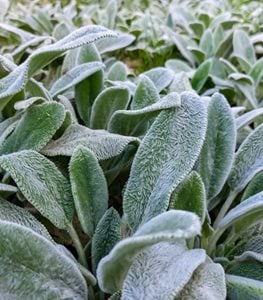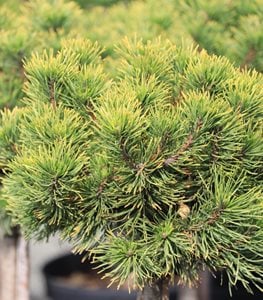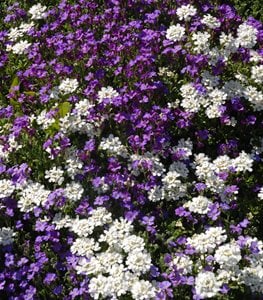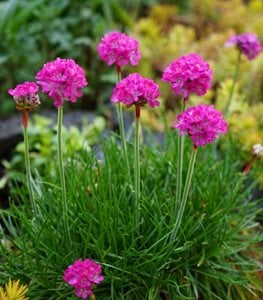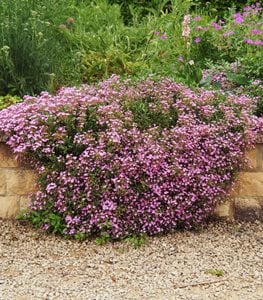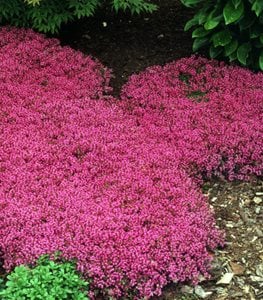25 Rock Garden Plants for a Colorful Low-Maintenance Garden
Add these tough plants to your landscape for low-maintenance colorA rock garden can add natural appeal to home landscapes, offering a low-maintenance alternative to water-thirsty lawns, mixed borders, and challenging areas such as steep slopes. This type of landscape consists of boulders, rocks, and gravel that are softened with a variety of plants.
Many rock garden plants originate in alpine regions, mountainous areas and other inhospitable places where soil is lean, rainfall is scarce, and extreme heat or cold are common. These plants have adapted to require less water, fertilizer, and other maintenance. Rock garden plants can be used for rockeries, xeriscapes, curbside strips, hypertufa containers, and waterwise borders. Here are some of the best rock garden plants to grow.
Also see: Rock Garden Design
ROCK GARDEN PLANTS
BUGLEWEED (Ajuga reptans and A. spp.)
Zones: 3-10, depending on the variety
Exposure: Full sun to full shade
Habit: Dense, mat-forming habit
Height/Spread: 3 to 12 inches tall, 6 to 24 inches wide
Bloom time: Late spring to early summer, some with re-bloom
Also known as bugleweed, this versatile perennial ground cover can be grown in sun or shade and is useful in difficult sites such as dry shade or underneath trees where little else will grow. Attractive evergreen or semi-evergreen foliage comes in an array of solid or variegated colors, with upright spikes of blue, pink, or white flowers in spring. Use in a semi-shaded or shaded rock garden. Learn more about growing bugleweed.
Pictured: 'Black Scallop' bugleweed from Proven Winners.
BASKET OF GOLD (Aurinia saxatilis)
Zones: 3-7
Exposure: Full sun
Habit: Mounding spreading habit
Height/Spread: 6 to 12 inches tall, 12 to 24 inches wide
Bloom time: Mid to late spring
Also known as yellow alyssum, this hardy herbaceous perennial produces gray-green foliage and clusters of bright yellow flowers that bloom for 4 to 6 weeks in spring. Basket of gold is especially showy when allowed to cascade over rock walls. Combine with other rock garden plants that bloom at the same time such as rock cress, aubrieta, and candytuft.
BLUE FESCUE (Festuca glauca)
Zones: 4-8
Exposure: Full sun
Habit: Compact clumping habit
Height/Spread: 10 to 12 inches tall, 24 to 28 inches wide
Bloom time: Late spring to summer
Blue fescue is an ornamental grass with a compact habit, dense spikes of steel-blue foliage, and tan flowers, adding fine texture and vivid color to the landscape. This hardy evergreen perennial has multi-season appeal, is drought tolerant, and virtually maintenance-free. Mass blue fescue in rock garden beds or use as edging.
BLUE STAR CREEPER (Isotoma fluviatilis syn. Laurentia fluviatilis)
Zones: 6-8
Exposure: Full sun to part shade
Habit: Low mat-forming habit
Height/Spread: 2 to 3 inches tall, 12 to 24 inches wide
Bloom time: Spring to summer
Isotoma fluviatilis is an herbaceous perennial ground cover that spreads to form a dense mat. Tiny pale-blue star-shaped flowers bloom in spring and summer against a backdrop of small, rounded green leaves. The carpet-like habit is useful for softening large rocks, as edging, or when planted in between stepping stones. Blue star creeper prefers moist conditions and is tolerant of moderate foot traffic.
CANDYTUFT (Iberis sempervirens)
Zones: 3-9
Exposure: Full sun
Habit: Mounding spreading habit
Height/Spread: 6 to 12 inches tall, 12 to 24 inches wide
Bloom time: Mid to late spring
This evergreen or semi-evergreen, woody-based perennial is most often grown as a ground cover. Plants produce small narrow green leaves and clusters of white flowers for weeks in spring. This tough plant is tolerant of drought and poor soils, preferring gravelly soil typically found in rock gardens. Candytuft looks especially attractive when allowed to cascade over rock walls or meandering through a rock garden.
CAMPANULA (Campanula spp.)
Zones: 3-9
Exposure: Full sun to partial shade
Habit: Upright, mounding or trailing habit
Height/Spread: 4 to 48 inches tall and wide
Bloom time: Late spring to early fall, depending on the variety
Also known as bellflower, Campanula produces white, blue, pink, or purple blooms and rounded or lance-shaped foliage. Perennial groundcover species such as Carpathian bellflower (Campanula carpatica), Serbian bellflower (C. poscharskyana), Dalmation bellflower (C. portenschlagiana), and ‘Birch Hybrid’ are commonly used in rock gardens. Allow campanula to naturalize in rock gardens or cascade over rock walls. Learn more about how to grow campanula.
Pictured: Takion Blue bellflower from Proven Winners.
COLUMBINE (Aquilegia spp.)
Zones: 3-9
Exposure: Full sun to partial shade
Habit: Upright or clump-forming habit
Height/Spread: 8 to 36 inches tall, 8 to 24 inches wide
Bloom time: Mid-spring to early summer
One of the most common alpine plants, this charming perennial is characterized by open-faced flowers with upwards or back-facing spurs. Plants produce delicate fern-like foliage and flowers in colors of pink, blue, purple, red, yellow, or white. Columbine self-seeds readily and can be allowed to naturalize in an alpine garden or along a rocky slope.
Pictured: Kirigami™ Deep Blue & White columbine from Proven Winners.
CORAL BELLS (Heuchera spp.)
Zones: 4-9
Exposure: Partial sun to partial shade
Habit: Mounding or spreading habit
Height/Spread: 6 to 18 inches tall, 12 to 30 inches wide
Bloom time: Late spring to mid-summer
Grown primarily for the foliage, coral bells varieties occur in a wide array of colors and shapes. This versatile evergreen or semi-evergreen perennial is tolerant of different growing conditions and is virtually maintenance-free. Use coral bells along walls, as edging, or in semi-shaded rocky landscapes. Learn more on how to grow coral bells.
Pictured: Primo® 'Wild Rose' coral bells from Proven Winners.
COTONEASTER (Cotoneaster spp.)
Zones: 3-8
Exposure: Full sun to partial shade
Habit: Upright or spreading habit
Height/Spread: 1 to 15 feet tall, 3 to 15 feet wide
Bloom time: Spring
This woody shrub offers multi-seasonal interest, with small evergreen or deciduous leaves, white or pink flowers, and brightly colored berries. Groundcover types that are commonly used in rock gardens include rockspray cotoneaster (Cotoneaster horizontalis), bearberry cotoneaster (C. dammeri), and creeping cotoneaster (C. adpressus). Use this tough, low-maintenance plant along slopes or rock walls.
DIANTHUS (Dianthus spp.)
Zones: 3-9
Exposure: Full sun to partial shade
Habit: Upright, mounding, or spreading habit
Height/Spread: 4 to 36 inches tall, 4 to 24 inches wide
Bloom time: Spring to early summer, some with repeat bloom
This cottage garden favorite produces strappy grass-like foliage and frilly flowers in nearly every color imaginable, from white to black. Dianthus species such as cheddar pinks (Dianthus gratianopolitanus) and alpine pinks (D. alpinus) prefer sandy soil and sharp drainage, making them especially suited to rockeries and slopes with poor soil. Learn more about growing dianthus.
Pictured: 'Paint the Town Magenta' dianthus from Proven Winners.
HEN AND CHICKS (Sempervivum spp.)
Zones: 4-10
Exposure: Full sun to partial shade
Habit: Low, mat-forming habit
Height/Spread: 6 to 12 inches tall, 6 to 18 inches wide
Bloom time: Spring to early summer, some with repeat bloom
This perennial succulent forms a central rosette with smaller offshoots, hence the common name of hen and chicks. Fleshy rosettes up to 12 inches wide come in a range of single and bicolor hues. This quintessential rock garden plant grows in narrow crevices and lean soil, and can be used to soften rock walls, as a spreading ground cover, or as edging. Learn more about growing hens and chicks plants.
ICE PLANT (Delosperma spp.)
Zones: 5-9
Exposure: Full sun
Habit: Low, mat-forming habit
Height/Spread: 3 to 6 inches tall, 12 to 30 inches wide
Bloom time: Late spring to fall, depending on the variety
Delosperma is a perennial succulent with small fleshy leaves and colorful daisy-like flowers. This mat-forming ground cover prefers lean, well-draining soil and hot, dry conditions, making it especially suited to rock gardens. Allow to spill over rock walls or use to cover bare gravel areas. Learn more about growing ice plant.
Pictured: Fire Spinner® hardy ice plant from Proven Winners.
IRISH MOSS (Sagina subulata)
Zones: 4-8
Exposure: Full sun to partial shade
Habit: Low spreading habit
Height/Spread: 1 to 2 inches tall, 6 to 12 inches wide
Bloom time: Spring to summer
This evergreen perennial with a moss-like appearance forms a dense green carpet. Plants just 1- to 2-inches tall produce tiny, white, star-shaped flowers in spring and summer. Use Irish moss to soften boulders or other rock features, as edging, or as filler between flagstone pavers. Tolerates light foot traffic.
JUNIPER (Juniperus spp.)
Zones: 2-10, depending on the variety
Exposure: Full sun
Habit: Upright, spreading, or weeping habit
Height/Spread: 6 inches to 130 feet tall, 1 to 25 feet wide
This evergreen conifer occurs in a wide range of sizes, shapes and colors. Dwarf and ground cover species such as creeping juniper (Juniperus horizontalis), singleseed juniper (J. squamata ‘Blue Star’) and common juniper (J. communis) are adaptable to rock or sandy soils, making them suitable for rock gardens. Add year-round interest to rock garden beds or slopes. Learn more about growing junipers.
Pictured: Montana Moss® juniper from Proven Winners.
LAMB'S EAR (Stachys byzantina)
Zones: 4-9
Exposure: Full sun to partial shade
Habit: Mounding or spreading habit
Height/Spread: 6 to 18 inches tall, 12 to 36 inches wide
Bloom time: Summer
Lamb’s ear is a Mediterranean native that is adaptable to a range of growing conditions including rocky or poor soil. This mat-forming perennial produces velvety silver leaves that resemble lamb’s ears and pink flower spikes. Use for gravel areas, as edging, or along rocky slopes to stem erosion. Learn more about growing lamb's ears.
LAVENDER (Lavandula spp.)
Zones: 5-11, depending on variety
Exposure: Full sun
Habit: Upright shrubby habit
Height/Spread: 1 to 4 feet tall, 1 to 5 feet wide
Bloom time: Late spring to early fall
This Mediterranean native thrives in hot, dry conditions and can be grown in lean soils as long as there is good drainage. This woody perennial produces attractive flower spikes and aromatic silver, grey, or green foliage. Add to rock garden beds or mass along a rocky slope to stem erosion. Learn more about growing lavender.
Pictured: Sweet Romance® lavender from Proven Winners.
MUGO PINE (Pinus mugo)
Zones: 2-7
Exposure: Full sun to partial shade
Habit: Upright spreading habit
Height/Spread: 2 to 5 feet tall, 3 to 6 feet wide
Also known as dwarf mountain pine, this hardy evergreen conifer has a mounding spreading habit and long spiky needles that add soft texture to the landscape. Mugo pine adds year-round color to rock garden beds, gravel areas, and Asian-style landscapes.
PHLOX (Phlox spp.)
Zones: 3-9
Exposure: Full sun
Habit: Upright, spreading or creeping habit
Height/Spread: 4 to 48 inches tall, 6 to 30 inches wide, depending on variety
Bloom time: Spring to fall, depending on variety
Phlox comes in a range of sizes, growth habits and flower colors. Perennial groundcover species including creeping phlox (Phlox stolonifera) and moss phlox (P. subulata) are commonly planted in rock gardens. Allow to sprawl in rock garden beds, to cascade over walls, or mass along a slope to stem erosion. Read more on how to grow phlox.
Pictured: 'Purple Sprite' spring phlox from Proven Winners.
ROCK CRESS (Aubrieta deltoidea)
Zones: 4-8
Exposure: Full sun to light shade
Habit: Low mat-forming habit
Height/Spread: 4 to 9 inches tall, 12 to 24 inches wide, depending on variety
Bloom time: Spring to summer
This semi-evergreen perennial has a vigorous mat-forming habit that is useful for covering large areas. Plants produce small green leaves and dainty flowers in colors of pink, purple, or white that cover the entire plant. Allow to cascade over a wall, plant in between stepping stones, or along a slope.
SEA THRIFT (Armeria maritima)
Zones: 3-9
Exposure: Full sun to partial shade
Habit: Low compact habit
Height/Spread: 6 to 12 inches tall and wide
Bloom time: Mid to late spring
This compact evergreen perennial produces slender grass-like foliage and rounded clusters of pink flowers. Sea thrift is slow growing, performing best in lean, well-drained soils. Plants are drought tolerant once established. Use as edging or naturalize in a rock garden bed.
SEDUM (Sedum spp.)
Zones: 3-9
Exposure: Full sun
Habit: Upright, mounding, or creeping habit
Height/Spread: 3 to 36 inches tall, 12 to 24 inches wide
Bloom time: Summer to fall
Sedum is a perennial succulent with fleshy leaves and clusters of small flowers that add late-season color to the landscape. These tough plants are tolerant of poor soils, drought, and are virtually maintenance free, making them a good choice for rock gardens. Plant in rock garden beds, mass along a slope, or allow trailing varieties to cascade over walls. Read more on how to grow sedum plants.
Pictured: Rock 'N Low® 'Boogie Woogie' sedum from Proven Winners.
SNOW IN SUMMER (Cerastium tomentosum)
Zones: 3-7
Exposure: Full sun
Habit: Spreading, mat-forming habit
Height/Spread: 6 to 12 inches tall, 9 to 12 inches wide
Bloom time: Late spring to early summer
Cerastium tomentosum is an herbaceous perennial with silver-grey foliage and white star-shaped flowers. Plants are exceptionally hardy, drought tolerant, and low maintenance. Use to fill pockets in stone walls or allow to cascade along slopes or walls.
SOAPWORT (Saponaria ocymoides)
Zones: 2-9
Exposure: Full sun
Habit: Low mat-forming habit
Height/Spread: 6 to 9 inches tall, 12 to 24 inches wide
Bloom time: Late spring to summer
This perennial groundcover produces small narrow leaves and bright pink star-shaped flowers in early summer. Plants are exceptionally hardy, drought resistant, and virtually maintenance-free. Allow to cascade over rock walls, plant along a slope, or in between pathway stepping stones.
CREEPING THYME (Thymus spp.)
Zones: 4-9
Exposure: Full sun
Habit: Creeping, spreading habit
Height/Spread: 1 to 4 inches tall, 12 to 24 inches wide
Bloom time: Summer
This groundcover herb produces tiny green, grey, or variegated leaves and pink or white flowers. Species commonly used in rock gardens include creeping thyme (Thymus serpyllum), wooly thyme (T. pseudolanuginosus), and mother of thyme (T. praecox). Use in a rock garden bed, as edging, or in between stepping stones. Find more on growing creeping thyme.
Pictured: red creeping thyme from Proven Winners.


